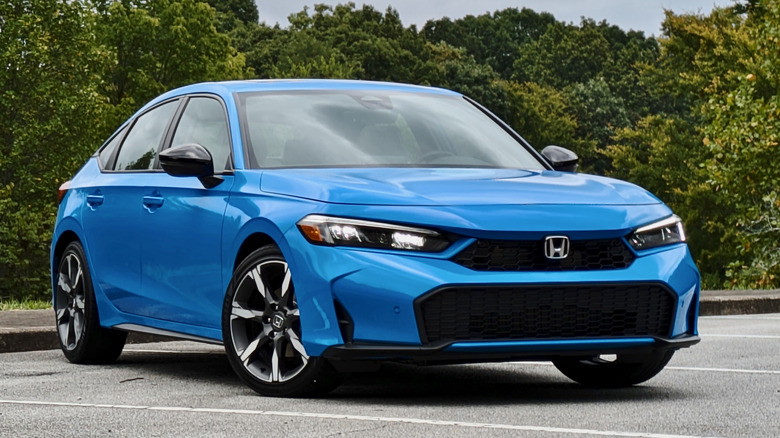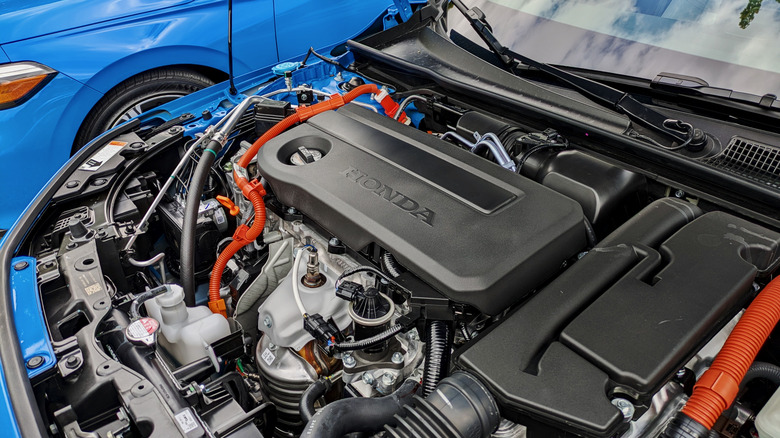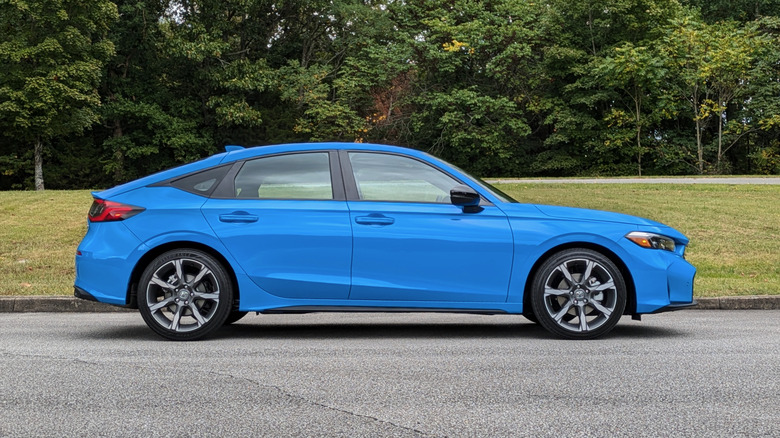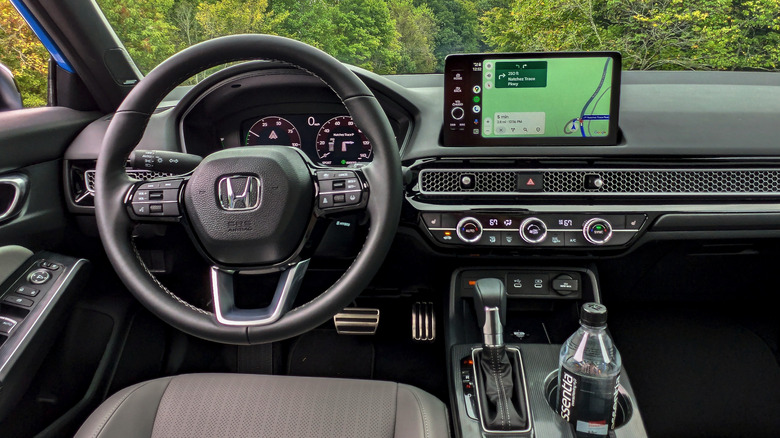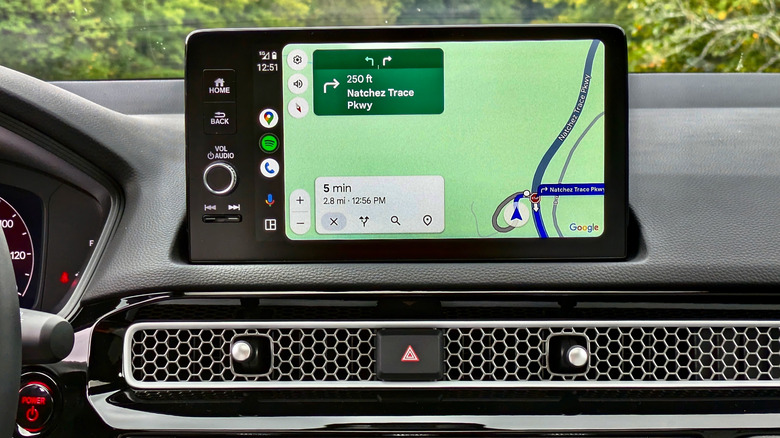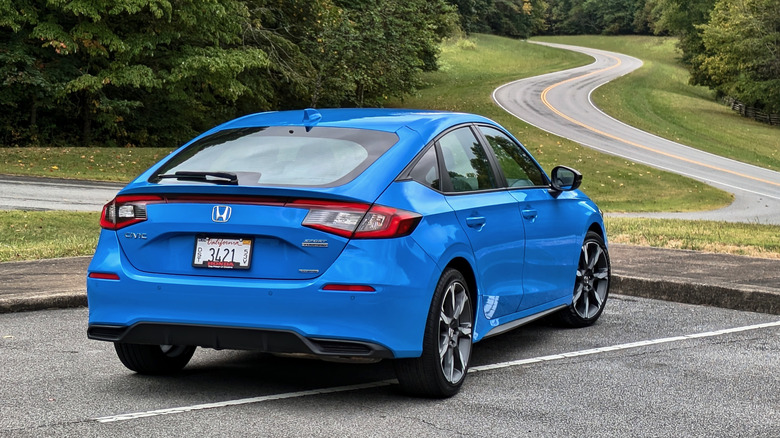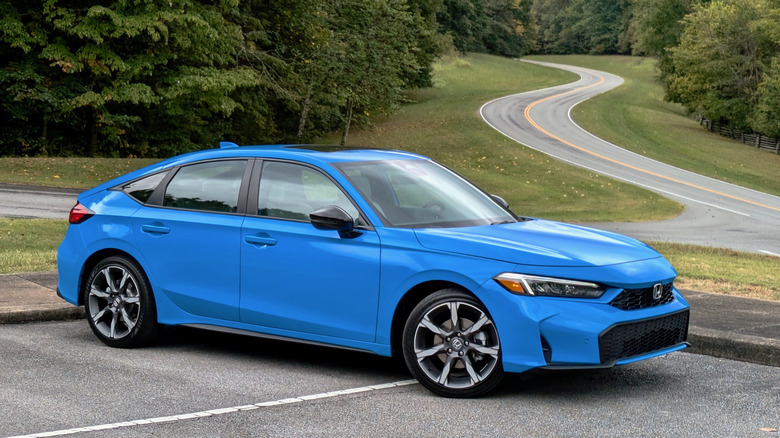2025 Honda Civic Hatchback Hybrid First Drive: More Power, More MPG, More Money
Few automakers combine sporty and sensible like Honda. Its familiar "H" logo adorns legions of Accords, Civics, and CR-Vs serving as reliable but anonymous transportation for people who barely notice what kind of car they're driving. Yet Honda's engineers also churn things like S2000s, NSXs, and Type Rs that would make Soichiro Honda—the company's racing-obsessed founder—proud.
The 2025 Honda Civic tries to bring those two sides of Honda closer together. This mid-cycle refresh of the 11th-generation Civic brings back the hybrid powertrain option, and offers it in combination with the hatchback body style for the first time, in addition to the sedan configuration. The new Civic hybrid is the first new Honda hybrid hatch since the 2014 Insight, in fact.
It's a combination so sensible it's quite frankly disgusting. But Honda claims the Civic hybrid hatch isn't just for people who enjoy making spreadsheets. The PR copy highlights torque and acceleration as well as mpg because, while the hybrid is no Civic Type R, it wasn't meant to be boring.
Plenty of power and mpg
Like the sedan, the hatchback uses a variant of Honda's two-motor hybrid system. This does away with a conventional transmission, and operates in a series configuration most of the time, with the gasoline engine acting as a generator, although it can switch to a parallel mode similar to most other hybrids in which both gasoline and electric power reach the wheels directly.
The 2025 Civic hybrid uses a 2.0-liter four-cylinder engine running on the efficiency-focused Atkinson cycle. It's a bit bigger than the engines Honda has previously used, which helps deliver 200 horsepower and 232 pound-feet of torque. That's the same amount of horsepower as the Civic Si performance model, but with more torque. The Civic hybrid is also substantially more powerful than the similar-sized Hyundai Elantra and Toyota Corolla hybrids.
More relevant to hybrid buyers, the Civic hybrid hatch also returns 48 mpg combined (50 mpg city, 45 mpg highway). That's respectable, but still just behind the maximum 54 mpg combined (51 mpg city, 58 mpg highway) of the Elantra hybrid and 50 mpg combined (53 mpg city, 46 mpg highway) of the Corolla hybrid.
Still, it's probably the best compromise Honda could come up with as it positions the hybrid powertrain as the upgrade for the Civic. Honda is so committed to making hybrids the future that it eliminated the 1.5-liter turbocharged four-cylinder engine from the regular Civic (a version of it is still available in the sedan-only Civic Si) to make room.
Sporty but calm driving dynamics
The transmission-less Honda hybrid system feels more normal in this Civic than in other Honda hybrids, where the powertrain is almost EV-like in the way it delivers torque to the wheels (but with a gasoline engine buzzing in the background). That rewards more-efficient driving because thrashing it isn't very satisfying.
Instead of needling you to drive more efficiently, the Civic hybrid hatch needles you to use as much of its 200 hp as possible. Smooth power delivery and consistent response from the accelerator encouraging pushing the pedal closer to the metal, as the kids say. Steering wheel paddles also call up more regenerative braking—a handy way to scrub off speed.
The hybrid also lives up to Honda's reputation for fun small cars. Even on the low rolling resistance tires typical of a hybrid, and with somewhat damp roads, there was plenty to spare. And while it wasn't as rambunctious as the Civic Si sedan Honda also had on hand for this test drive, the hybrid's lack of body roll and precise steering made it very pleasant on twisty roads.
This character makes the Civic hybrid perfect for those who enjoy driving but don't want to put up with harsh performance-tuned suspension or the comparably spiky power bands of a non-hybrid. While the Civic Si was the more involving car, in part because you can shift gears yourself with its six-speed manual transmission, the hybrid's extra dollop of torque gave it a calmer feel.
A practical daily driver
Among the updates for the 2025 model year are a new lower B-pillar support and rear door sill support for the body shell for increased rigidity, as well as stiffer mounting points for the suspension and front subframe. These changes not only contribute to the aforementioned handling, but also make the Civic hatchback more quiet and more comfortable in less-exciting situations.
On the highway drive back to downtown Nashville, Tennessee, from the nearby Natchez Trace Parkway, the Civic's sporty suspension tuning didn't affect ride comfort. The compact hatchback had a feeling of solidity that belied its economy-car status, and wind and tire noise were minimal at highway speeds.
A high quality interior also helps make the daily-driving experience nicer. The design hasn't changed much from the current-generation Civic's introduction a few years ago, but that's okay. The thin strip of air vents and freestanding touchscreen allow the dashboard to be slimmer, enhancing forward visibility and providing a more open feel. Rear visibility was decent as well despite the hatchback's thick rear roof pillars and angled rear window.
Materials are plain, but Honda at least didn't resort to excessive metallic plastic or piano black trim that would have only made the interior look cheaper. Bucking another industry trend, Honda also showed that it's still possible to package a wireless charging pad and decent-sized cupholders with a conventional shifter. If you're going to be stuck in traffic, there are worse places to be.
Updated tech costs extra
While the interior delivers more than expected for an economy car in terms of look and feel, Honda still limits key infotainment features to the most-expensive Sport Touring Hybrid trim level.
The Sport Touring Hybrid is the only 2025 Civic hatchback grade to get wireless Apple CarPlay and Android Auto (lower trim levels have wired versions), as well as the Google built-in features that are new to Honda, but have been available from other brands for a few years now.
As with previous applications, Google built-in incorporates native Google Maps, Google Assistant, and Google Play Store apps in place of generic navigation, voice control, etc. It substitutes a familiar interface for the hit-or-miss versions automakers have been coming up with, although it will be very unfortunate for owners if Google stops supporting its automotive built-in features.
We had no issues using the Google features in a Sport Touring Hybrid test car, and found the interface reasonably easy to navigate. Sport Touring Hybrid models have a 9.0-inch touchscreen and 10.2-inch digital instrument cluster, as opposed to the 7.0-inch touchscreen and 7.0-inch cluster in lower trim levels, so we can't speak to the experience of the base-model infotainment system.
Honda does at least make expected driver-assist features like adaptive cruise control, automatic emergency braking, and lane keep assist standard, which matches or exceeds the offerings of rival brands. For 2025, most of these features are updated for smoother operation and better for performance as well.
Simple styling and plenty of cargo space
The styling of the current-generation Civic is about as far from that of its predecessor as can be. Today's model is simple and conservative, making the extravagantly styled previous generation seem like a fever dream in retrospect. While not as daring, it's hard to fault the design of the 2025 Civic hatchback. With few extraneous lines and a shape that emphasizes its compact dimensions, it looks like a true Honda.
Honda made some small alterations for 2025, however, with mixed results. The good news is that all Civic models now feature a mesh grille similar to one that was previously available only on certain trim levels. It eliminates the oversized-forehead look of the front end on models that didn't have that grille. The bad news is that Honda also gave every 2025 Civic model a new front fascia with a jutting hexagonal lower air intake that leaves the car with something of a duck face, and also doesn't quite match up with the new vertical intakes that frame it.
The most important part about the 2025 Honda Civic is at the back, anyway. It's a big deal that Honda is offering the hybrid powertrain in a hatchback, as the rival Hyundai Elantra and Toyota Corolla hybrids are only available as sedans. The Civic hybrid also be cross-shopped against a Toyota Prius, but that hatchback's dramatic styling means it offers less rear headroom, legroom, and cargo space than the Civic hatch.
Spend more, get more
With a livelier driving experience than equivalent hybrids and an impressive combination of fuel efficiency and hatchback practicality, the 2025 Honda Civic hybrid hatchback is a very complete car. But shoppers who just want a frugal car should probably consider the alternatives.
The Sport Hybrid starts at $31,045 with destination, or $2,500 more than the non-hybrid Sport grade. But that model's 2.0-liter four-cylinder engine is down 50 hp and 99 lb-ft of torque from the hybrid powertrain, and is less fuel efficient too. The Sport Touring Hybrid starts at $34,045, adding more comprehensive tech features.
Hatchbacks are also $1,200 more than equivalent Civic hybrid sedans, but even those are pricier than compact hybrids from other brands. The Hyundai Elantra Hybrid sedan starts at $26,250, while the Toyota Corolla Hybrid sedan is priced even lower at $24,635. Civic hybrids are well equipped, with standard features like heated front seats and dual-zone automatic climate control, but it's definitely a case of spending more to get more.
This is all in keeping with Honda's strategy, though. In hatchback or sedan form, the Civic hybrid was meant to be the top-of-the-line model, so buyers looking to upgrade would also have to go hybrid. Whether that will make more electrification converts out of Civic buyers who just wandered into the showroom looking for a new car with a familiar name remains to be seen, but the 2025 Civic hybrid hatchback does a great job of embodying both sides of Honda's personality.
